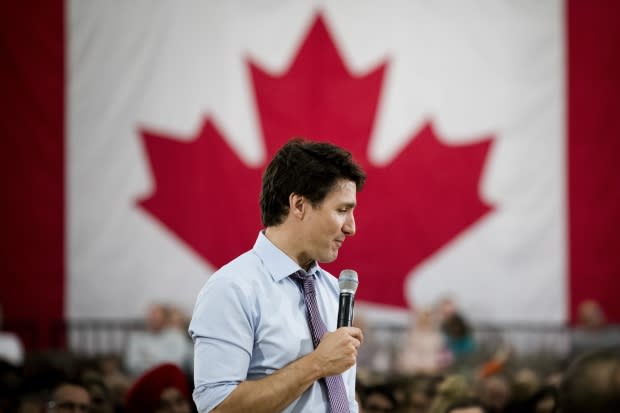With 6 months to go, Justin Trudeau is up against history
Half a year is a long time in politics, but when you're trailing in the polls it might not feel like it's long enough.
That's where Justin Trudeau's Liberal government finds itself with six months to go before the fall federal election.
And when past prime ministers have been in this spot before, it generally hasn't ended well for them.
Since the Second World War, when political public opinion polling first started in Canada, the governing party has trailed in the polls six to eight months before the subsequent election nine times.
On two occasions, that party was reduced to a minority government. On five occasions, it was defeated. On only two occasions did it secure a majority.
For parties that led in the polls this far out from election day, it's a much different picture: of the 14 such cases since 1945, the party leading has been defeated just three times.
That's a bad historical precedent for Prime Minister Trudeau.
According to the CBC's Canada Poll Tracker, an aggregation of all publicly available polling data, the Liberals trail the Conservatives by a margin of 2.5 percentage points, with 32.7 per cent against 35.2 per cent for Andrew Scheer's party.
On average, prime ministers who met defeat at the ballot box trailed in the polls by a margin of three points at the six-month mark. Those parties that went on to re-election with a majority government enjoyed an average lead of 12 points at the six-month mark.
Obviously, much can change in six days before an election, let alone six months. Still, the historical record shows it's much better to be ahead than behind, even this far out.
Exceptions that prove the rule
Past prime ministers have successfully overcome wider polling deficits than the one Trudeau faces now. But those were exceptional cases.
Ahead of the 1962 election, John Diefenbaker's Progressive Conservatives were behind Lester Pearson's Liberals by a margin of six points. In the end, Diefenbaker managed to hold on but was sent back to Ottawa with a shaky minority government that met its end within a year.
In early 1988, Brian Mulroney's PCs were behind by seven points. But Mulroney was able to turn the November federal election into a referendum on the free trade agreement with the United States, keeping his party in power in the process.
At the end of 1967, the Liberals were trailing the PCs and their newly installed leader, Robert Stanfield, by nine points. It took a change of leadership of their own for the Liberals to win in 1968 under Pierre Trudeau.

Pierre Trudeau barely overcame the odds again after just one term in 1972. He was narrowly behind Stanfield going into that fall's election and emerged with a minority government.
That isn't the only example that has some familiar (as well as familial) connections to the current Trudeau government. The Liberals were trailing behind the PCs by a similar margin at the end of 1978, before Joe Clark's short-lived minority government was elected in 1979.
There are a few exceptions on the other side of the ledger, too. Louis St-Laurent lost despite a 17-point lead in 1957 after 22 years of Liberal government, Paul Martin was ahead by 10 points in 2005 before he lost his lead to the Conservatives over the course of the 2005-06 campaign. And Stephen Harper was narrowly ahead in 2015 at the six-month mark, though that was due to the opposition vote being divided between Trudeau's Liberals and Tom Mulcair's New Democrats.
Scheer, Singh on par with predecessors
Both the Conservatives and the NDP are roughly where those parties tend to be at this stage of the pre-election period.
At just over 35 per cent nationwide, Scheer's party is about even with where past Conservative parties under different leaders have stood with six months to go. Excluding the run-up to the 1997 and 2000 elections — when the right was divided between the PCs and the Reform/Canadian Alliance parties — the Conservatives have averaged 34 per cent support with six months to go before an election.
It's a level of support that can go either way. Clark's party was at 37 per cent at this stage before his defeat in 1980, while Diefenbaker's PCs were also at 37 per cent before he was reduced to a minority government in 1962. Stanfield's party had 35 per cent support at the six-month mark before he held Pierre Trudeau to a minority in 1972, while Harper's Conservatives were at 35 per cent before he was re-elected in 2008.
The NDP's current standing in the polls is very typical for the party this far out from voting day. With 15.3 per cent, Jagmeet Singh's NDP is just slightly below the 16 per cent average the party and its predecessor, the CCF, have managed at this point in election cycles since 1945. It puts Singh right in the middle of the pack of historical NDP performances.
Liberals at their lowest, except for the last three times
The Liberals' current level of support, however, is atypical. The Liberals have averaged 40 per cent support six months ahead of past elections — but the party's current 33 per cent support puts Trudeau's Liberals in 21st place out of 24 past elections. The only pre-election periods in which the Liberals had lower support than they do today were in 2008, 2011 and 2015 — the last three federal votes.
Of those, the 2011 election was the worst the Liberal Party of Canada has ever experienced. The last one in 2015 saw the Liberals win the most seats they have since 1949.
It's a reminder that history is not always doomed to repeat itself. Looking at where the numbers stand six months before Canadians render their verdict on Trudeau's time in power, and the record of his predecessors in the office, the prime minister must be hoping for a clean break with history.

